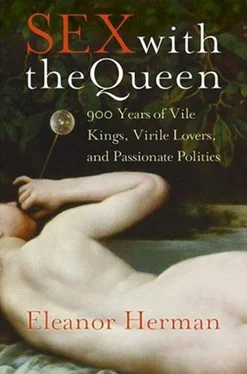But this time Isabella was no longer a meek child. At twenty-five, she had ruled a nation for almost a decade and was not about to put up with another of her husband’s lovers robbing her. On a visit to her family in France, Isabella took a powerful lover who would help her wage war against her husband. Roger Mortimer, in his early forties, had been one of Edward’s successful generals against the Scots. But when the king confiscated his lands and castles, Mortimer became his deadliest enemy. Confined to the Tower of London, Mortimer arranged to have the guards drugged, rappelled down the battlements on a rope, swam the Thames, and escaped to France.
We can imagine that first night when Queen Isabella let Mortimer into her room. She had known only the smooth girlish hands of Edward upon her; in their most intimate joining her husband must have fantasized that he was actually making love to Piers Gaveston. And now this heated warrior took her, roughly at first, then tenderly. And he never, ever, imagined she was a man.
They made love at night and war during the day. Isabella began to dress as a widow and publicly proclaimed, “Someone has come between my husband and myself….I protest that I will not return until this intruder has been removed but, discarding my marriage garment, I shall assume the robes of widowhood and mourning until I am avenged of this Pharisee.” 7
Armed with foreign troops, Isabella and Mortimer invaded England. Edward II and the Le Despensers fled but were soon captured. The favorites were hanged, cut down still alive, their bowels were cut out, their arms and legs hacked off, and their body parts fed to wild dogs.
It was one thing for Isabella to execute the hated Le Despensers, quite another to murder an anointed king and her husband. Shakespeare summed up the feeling when he wrote, “Not all the water in the rough rude sea can wash the balm off an anointed king.” Isabella locked Edward up, forced him to abdicate, and had her fifteen-year-old son proclaimed Edward III. Because her son was young, she ruled England with Mortimer, flinging aside her widow’s weeds. But Mortimer was, after all, a heterosexual version of Gaveston and the Le Despensers. Greedy, arrogant, and ambitious, he, too, confiscated estates from their rightful owners.
Public support shifted back in favor of the deposed king who, sitting in his cell, wrote self-pitying poetry. “And call me a crownless King,” he opined, “a laughing stock to all.” 8Despite his wretched condition, he still posed a threat to Isabella and Mortimer, especially after two failed rescue attempts by his supporters. In 1327 Edward was murdered in his cell, supposedly by a red-hot poker being thrust up his anus inside a cow’s horn, so no one would see any marks, or as one chronicler put it, “slain with a hot spit put thro the secret place posterial.” 9Isabella and Mortimer were not only detested tyrants. Now they had murdered a king.
In 1330 the eighteen-year-old Edward III eyed Mortimer’s increasing arrogance with concern. The young king was worried that his mother’s lover would have him murdered as well and reign in his stead, perhaps hoping to found his own dynasty with Isabella, who was still only thirty-four years old. Together with numerous barons robbed by Mortimer, Edward had him arrested. He was hanged, and the grieving Isabella remained in genteel confinement for two years before she was completely rehabilitated as Queen Mother. All her sins were thrown onto the shade of Roger Mortimer.
Perhaps to make up for the misdeeds of the past, Isabella became quite pious, frequently visiting saints’ shrines. In her lavish apartments songbirds sang their sweet melodies, and minstrels played courtly tunes. For the Saint George’s Day celebrations in 1358, shortly before her death at the age of sixty-two, she wore a circlet of gold on her head, belts of silk studded with silver, eighteen hundred pearls (probably seed pearls), and three hundred rubies. She was buried, oddly enough, in her wedding gown, holding the casket of her husband’s heart, which she had never truly possessed while he was alive.
JUANA OF PORTUGAL, QUEEN OF CASTILE: THE GOLDEN TURKEY BASTER
While Edward II fathered four children with Isabella, another early king thought to be homosexual, Enrique IV of Castile, could not rise to the occasion with either of his two wives, no matter how hard he tried. Yet this resourceful monarch came up with a novel plan—an early form of artificial insemination.
A large shambling man, painfully shy and eternally forlorn, Enrique had gorgeous golden hair and dreamy blue-green eyes which contrasted strangely with his huge yellow horses’ teeth and a flat crooked nose, broken in a childhood accident. He rarely bathed, perhaps because he had a bizarre fascination for repulsive odors.
While still heir to the throne, the fifteen-year-old Enrique was married to Princess Blanca of Navarre, daughter of King Juan of Aragon, in 1440. When the couple was put to bed, heralds stood guard at the door ready to blast their trumpets when the bloody sheets were brought out. Three notaries sat next to the bed, quills poised to record the first shriek or moan as proof of consummation. Stripped of her white nightgown, Blanca slid between the sheets. Enrique entered and slipped in beside her. The bed curtains were closed. The notaries seated themselves, leaning forward, listening intently. The candles burned down, guttering in the deadly silence of the room. The notaries shifted uneasily on the hard bench.
Outside waited crowds of courtiers, as well as Enrique’s father, King Juan II. But no bloody sheet came out as proof. Nothing happened. Finally the notaries gave up and went to bed. One report related, “The Princess remained exactly as she had been born.” 10
Many hoped that with time the fifteen-year-old prince would fulfill his connubial duties; perhaps his youth and the frayed nerves of the wedding night had frightened him. But the months went by, and then the years, and no bloody sheet ever emerged. Some whispered that the prince was homosexual, and indeed he kept company with men known to be gay.
It was a somber event indeed when the ruler of a Spanish kingdom—Castile, Leon, Aragon, Galicia, or Valencia—died without an heir. Fractious neighboring kingdoms, all jockeying for superiority, were eager to swoop down upon his realm and claim it for themselves. When, after thirteen years of marriage, Blanca still remained a virgin, the archbishop of Toledo moved to annul the marriage on the grounds of nonconsummation.
Blanca shamefacedly took the stand and swore she was still a virgin. She underwent a physical examination by honorable matrons who declared her to be as “whole as the day she was born.” 11She was sent back to her father, who was furious with her for not being able to rouse her husband to his bedtime duties.
When doctors examined Enrique, they found that His Majesty’s “penis was thin and weak at the base, but huge at the head, with the result that he could not have an erection.” 12He began to be known as “Enrique the Impotent.”
But the king did not agree that he was hopelessly incapable of making love to a woman. A new wife was needed, he claimed. Clearly his penis had been bewitched with regard to Blanca, but he had hopes that he could be aroused with a different woman and could sire an heir. As soon as he became king in 1454, Enrique ordered a new bride, Princess Juana of Portugal. The sixteen-year-old princess had flashing dark eyes, long black hair, and tawny skin. She was sleek, sinuous, and flirtatious. Freshly scrubbed and scented after her journey, she must have been revolted when she met her groom, tall and hunched and hulking, smelling of sweat and horse.
After the wedding ceremony, the royal couple entered the bedchamber. The king had fortified himself with the Viagra of the time, broth of bulls’ testicles mixed with powder of porcupine quills. He refused to allow notaries in the room. No sheet showing that night, he announced. But it was all in vain because, once more, it was reported that “the King and Queen slept in the same bed, and the Queen remained as intact as she had arrived.” 13
Читать дальше












